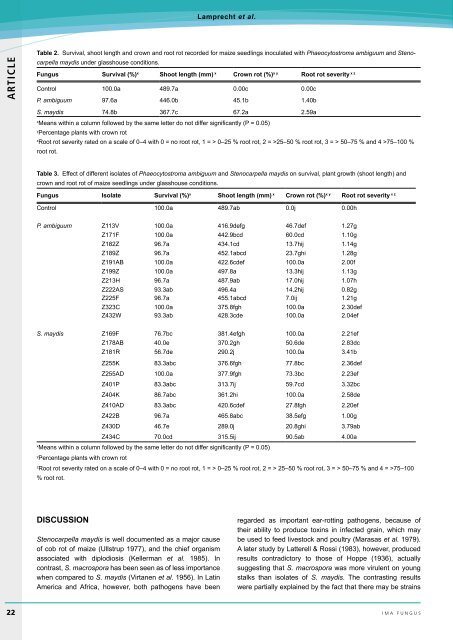Lamprecht SC, Crous PW, Groenewald JZ ... - IMA Fungus
Lamprecht SC, Crous PW, Groenewald JZ ... - IMA Fungus
Lamprecht SC, Crous PW, Groenewald JZ ... - IMA Fungus
Create successful ePaper yourself
Turn your PDF publications into a flip-book with our unique Google optimized e-Paper software.
<strong>Lamprecht</strong> et al.<br />
ARTICLE<br />
Table 2. Survival, shoot length and crown and root rot recorded for maize seedlings inoculated with Phaeocytostroma ambiguum and Stenocarpella<br />
maydis under glasshouse conditions.<br />
<strong>Fungus</strong> Survival (%) x Shoot length (mm) x Crown rot (%) x y Root rot severity x z<br />
Control 100.0a 489.7a 0.00c 0.00c<br />
P. ambiguum 97.6a 446.0b 45.1b 1.40b<br />
S. maydis 74.8b 367.7c 67.2a 2.59a<br />
x<br />
Means within a column followed by the same letter do not differ significantly (P = 0.05)<br />
y<br />
Percentage plants with crown rot<br />
z<br />
Root rot severity rated on a scale of 0–4 with 0 = no root rot, 1 = > 0–25 % root rot, 2 = >25–50 % root rot, 3 = > 50–75 % and 4 >75–100 %<br />
root rot.<br />
Table 3. Effect of different isolates of Phaeocytostroma ambiguum and Stenocarpella maydis on survival, plant growth (shoot length) and<br />
crown and root rot of maize seedlings under glasshouse conditions.<br />
<strong>Fungus</strong> Isolate Survival (%) x Shoot length (mm) x Crown rot (%) x y Root rot severity x z<br />
Control 100.0a 489.7ab 0.0j 0.00h<br />
P. ambiguum Z113V 100.0a 416.9defg 46.7def 1.27g<br />
Z171F 100.0a 442.9bcd 60.0cd 1.10g<br />
Z182Z 96.7a 434.1cd 13.7hij 1.14g<br />
Z189Z 96.7a 452.1abcd 23.7ghi 1.28g<br />
Z191AB 100.0a 422.6cdef 100.0a 2.00f<br />
Z199Z 100.0a 497.8a 13.3hij 1.13g<br />
Z213H 96.7a 487.9ab 17.0hij 1.07h<br />
Z222AS 93.3ab 496.4a 14.2hij 0.82g<br />
Z225F 96.7a 455.1abcd 7.0ij 1.21g<br />
Z323C 100.0a 375.8fgh 100.0a 2.30def<br />
Z432W 93.3ab 428.3cde 100.0a 2.04ef<br />
S. maydis Z169F 76.7bc 381.4efgh 100.0a 2.21ef<br />
Z178AB 40.0e 370.2gh 50.6de 2.83dc<br />
Z181R 56.7de 290.2j 100.0a 3.41b<br />
Z255K 83.3abc 376.6fgh 77.8bc 2.36def<br />
Z255AD 100.0a 377.9fgh 73.3bc 2.23ef<br />
Z401P 83.3abc 313.7ij 59.7cd 3.32bc<br />
Z404K 86.7abc 361.2hi 100.0a 2.58de<br />
Z410AD 83.3abc 420.6cdef 27.8fgh 2.20ef<br />
Z422B 96.7a 465.8abc 38.5efg 1.00g<br />
Z430D 46.7e 289.0j 20.8ghi 3.79ab<br />
Z434C 70.0cd 315.5ij 90.5ab 4.00a<br />
x<br />
Means within a column followed by the same letter do not differ significantly (P = 0.05)<br />
y<br />
Percentage plants with crown rot<br />
z<br />
Root rot severity rated on a scale of 0–4 with 0 = no root rot, 1 = > 0–25 % root rot, 2 = > 25–50 % root rot, 3 = > 50–75 % and 4 = >75–100<br />
% root rot.<br />
Discussion<br />
Stenocarpella maydis is well documented as a major cause<br />
of cob rot of maize (Ullstrup 1977), and the chief organism<br />
associated with diplodiosis (Kellerman et al. 1985). In<br />
contrast, S. macrospora has been seen as of less importance<br />
when compared to S. maydis (Virtanen et al. 1956). In Latin<br />
America and Africa, however, both pathogens have been<br />
regarded as important ear-rotting pathogens, because of<br />
their ability to produce toxins in infected grain, which may<br />
be used to feed livestock and poultry (Marasas et al. 1979).<br />
A later study by Latterell & Rossi (1983), however, produced<br />
results contradictory to those of Hoppe (1936), actually<br />
suggesting that S. macrospora was more virulent on young<br />
stalks than isolates of S. maydis. The contrasting results<br />
were partially explained by the fact that there may be strains<br />
22 i m a f U N G U S
















